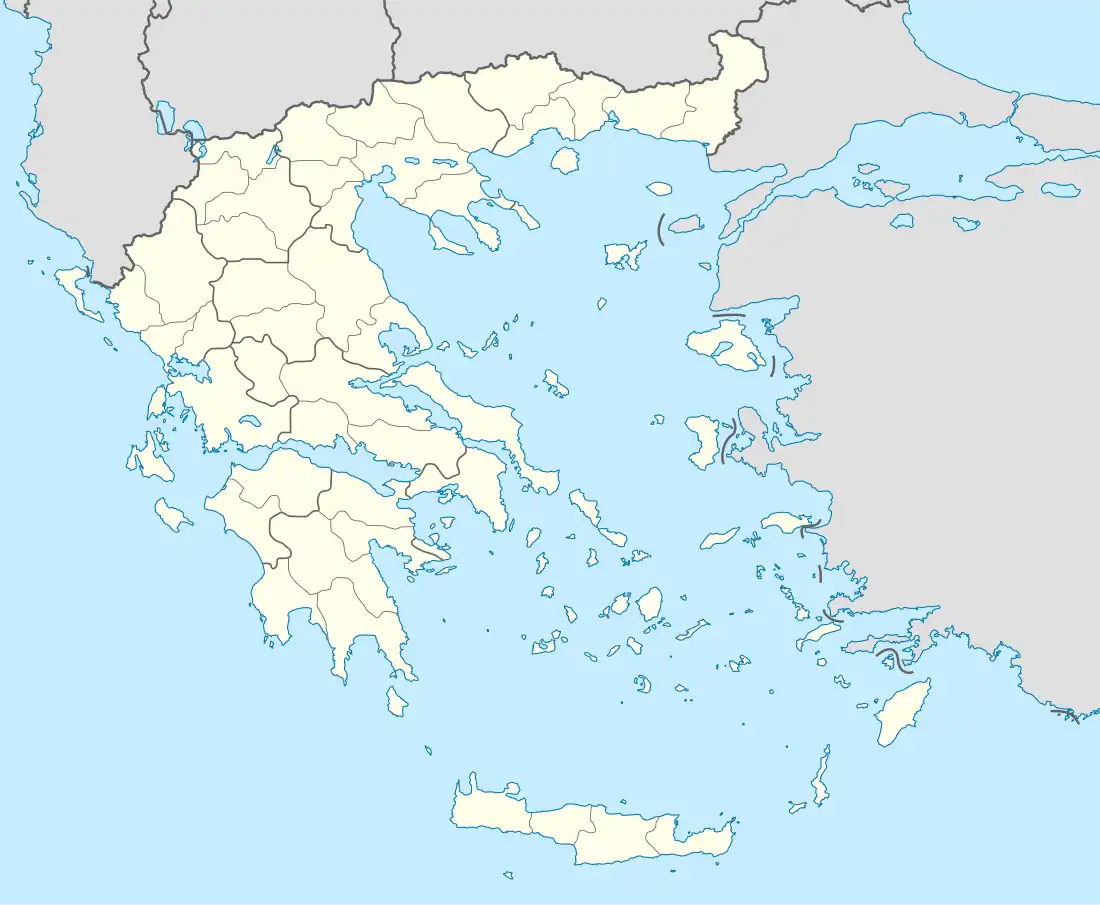Anthousa, Preveza
Anthousa (Greek: Ανθούσα), known before 1927 as Rapeza (Greek: Ράπεζα[2][3]) is a village in the municipality of Parga, Preveza regional unit of Epirus, in western Greece. In 2011 its population was 621 for the village and 677 for the community, which includes the village Trikorfo. Anthousa is situated 3 km northwest of the town Parga, under a Turkish castle on a hill, attributed to Ali Pasha. Remains and coins of the ancient city of Elaia have been found near the village.
Anthousa
Ανθούσα | |
|---|---|
 The early 19th century castle built by Ali Pasha in Trikorfo | |
 Anthousa | |
| Coordinates: 39°18′N 20°22′E | |
| Country | Greece |
| Administrative region | Epirus |
| Regional unit | Preveza |
| Municipality | Parga |
| Municipal unit | Parga |
| Population (2011)[1] | |
| • Rural | 621 |
| Community | |
| • Population | 677 (2011) |
| Time zone | UTC+2 (EET) |
| • Summer (DST) | UTC+3 (EEST) |
History
Tombs of the Hellenistic and Roman era have been unearthed in the area of the municipal unit of Anthousa.[4] In the 12th century the monastery of Virgin Mary of Vlacherna was erected. Traces of a Venetian garrison are also visible.[5]
In 1814 Anthousa was plundered by units of the Albanian ruler Ali Pasha and the local inhabitants fled to nearby Parga.[6] Ali Pasha then built a castle over Anthousa in order to plan a siege against Parga.[7]
Anthousa was one of the Christian Orthodox Albanian-speaking villages (Albanian: Rapëza),[8]), which either due to the absence of Greek or for reasons of demographic importance, would see Greek education expanded through measures such as the establishment of kindergartens.[9]
In Anthousa and also Kanallaki, the closest existing variants of Souliotic Albanian are spoken. This dialect is spoken only by few people in modern times.[10]
Population
| Year | Village population | Community population |
|---|---|---|
| 1951 | 592 | 742 |
| 1981 | - | 870 |
| 1991 | 586 | - |
| 2001 | 624 | 683 |
| 2011 | 621 | 677 |
References
- "Απογραφή Πληθυσμού - Κατοικιών 2011. ΜΟΝΙΜΟΣ Πληθυσμός" (in Greek). Hellenic Statistical Authority.
- "Διοικητικές Μεταβολές Οικισμών – Αναλυτικά: Ανθούσα (Πρεβέζης)" (in Greek). Hellenic Agency for Local Development and Local Government. Retrieved 28 August 2022.
- Hammond, N. G. L. (1967). "The Ancient Remains in the South-Western Districts: The Canton of Margariti". Epirus: The geography, the ancient remains, the history and the topography of Epirus and adjacent areas. Oxford University Press. p. 77.
I was told that coins were found in the immediate vicinity of Parga, at a small village called Rapeza, north-west of Parga, and at Ayia, further to the north-west, and that ancient tombs had been opened near Rapeza. [...] He also saw cist tombs and a piece of polygonal retaining wall, and he heard of Byzantine and Venetian coins, all in the vicinity of Anthousa, which I take to be the new name of Rapeza.
- Golias, 2006, p. 100
- Golias, 2006, p. 103
- Σμύρης, Γεώργιος (1 January 2000). "Το δίκτυο των οχυρώσεων στο Πασαλίκι των Ιωαννίνων: 1788 -1822 ιστορική - πολιτική - οικονομική και χωροταξική θεώρηση". National Technical University of Athens (in Greek). Εθνικό Μετσόβιο Πολυτεχνείο (ΕΜΠ). Σχολή Αρχιτεκτόνων Μηχανικών: 171. doi:10.12681/eadd/12426. Retrieved 19 July 2023.
- Golias, 2006, p. 69
- Lito, Zana (1999). Shqiptarët në Greqi. Botimpex. p. 27. ISBN 9992762837.
- Baltsiotis. The Muslim Chams of Northwestern Greece. 2011. "Parallel measures were taken at the same time regarding the language in Christian Albanian speaking villages. The most important and easily confirmed measure consisted of opening kindergartens in villages selected either by the absence of knowledge of Greek or by their demographic importance. According to a 1931 document, these villages included Aghia, Anthoussa, Eleftheri[o], Kanallaki, Narkissos, Psakka, Aghios Vlassios, Kastri (Dagh) and Draghani."
- Psimuli 2016, pp. 180–81
Sources
- Golias, Vasilis (2006). "Τουρισμός και Τοπική Ανάπτυξη. Η περίπτωση του Δήμου Πάργας" (PDF). TEI of Kalamata. Retrieved 25 October 2022.
- Ψιμούλη, Βάσω Δ. (2006). Σούλι και Σουλιώτες. Ιστορία και Πολιτική (4th ed.). Athens: Βιβλιοπωλείον της Εστίας.
- Psimuli, Vaso Dh. (2016). Suli dhe suljotët [Souli and the Souliots]. Toena. ISBN 9789928205728.